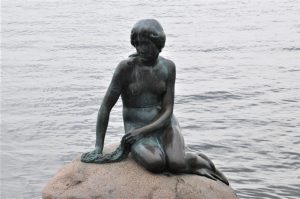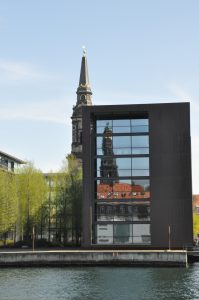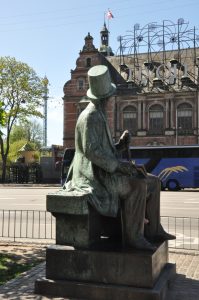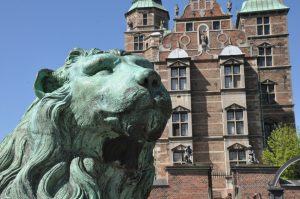I don’t like Rick Steves’ television persona. I find him sanctimonious, arrogant and supercilious, veneered with faux naiveté and faked authority.
I don’t like his insistence that the primary and dominant function of travel is “getting to know” the locals—whether or not they want to get to know some random tourist. I take offense at his demeaning comments about people like me who dedicate significant travel hours to museums and historical sites. When he does talk about museums, and especially the art and objects they contain, his comments are jejeune and his statements often flat-out wrong.
I suspected his books were of dubious value in Paris last year when I lost my Streetwise map but found the Steves’ map some other hapless tourist dropped. Just not worth the paper it was printed on.
Stuck, however, with Rick Steves Snapshot: Copenhagen & the Best of Denmark (2015), I can affirm that he writes a crappy guidebook. It covers very little. The maps are poor quality and difficult to decode. It is in no sense an easy reference in which one might quickly get basic questions answered. There are a number of good series out there: Lonely Planet and Fodors for instance. We are aficionados of the Eyewitness Guides published by Dorling Kindersley. They’re not perfect, far from it, and they weigh a ton given their size because of the expensive coated stock used for printing. They are, however serious guides and the writers know that it is not their job to rhapsodize or demonize but give the best and most correct facts.
Eyewitness Guides, for instance, suggests walks. So do the Snapshot guides. Steves, however, recommends for Copenhagen a single insane walk that would not serve any visitor and fundamentally transgresses his own rule about slowing down and being in the moment. Steves’ idea of a walk is the urban equivalent to the film If it’s Tuesday, this must be Belgium.
Now Copenhagen is not Paris and doesn’t need half a dozen different walks, but it could use at least three that encourage more than a glimpse from the sidewalk. Steves terminates his single tour with the option of continuing past Nyhavn and offers this injunction at Kastellet Park: “Climb up the stairs by the fountain and continue along the top of the rampart about five minutes to reach the harborfront site of the overrated, overfondled, and overphotographed symbol of Copenhagen, Den Lille Havfrue…” He goes on to slam interpreters like Danny Kaye (my generation) and Disney (my son’s generation) but does refer the reader back to the original tale. Everyone should, of course, read fairy tales in their original text: Charles Perrault’s Cinderella; Carlo Collodi’s Pinocchio; Hans Christian Anderson’s Little Mermaid. That doesn’t mean that we should abuse the sentimental attachments of children who were left with animated and bowdlerized versions.
Here’s what I might suggest.
Christianshavn and Christiana between them make a beautiful walk. There’s a couple of fine churches there, notably Vor Frelsers Kirke (Our Savior’s) with its famed spiral tower. If you have the 40 DKK, the fortitude for the 400-step climb, and if the line is not too long, the tower is reputed to offer the best view in Copenhagen. Then on to the hippie zone of Christiania, the ramparts above Stadsgraven, some new neighborhoods, the Opera House and the pedestrian bridge over Inderhavnsbroen. If you have planned sufficiently far in advance, and are feeling flush, there is also the new incarnation of Michelin-starred Noma, for several years considered “the best restaurant in the world.”
Another stroll might take you over the Langebro from Christianshavn. Walk up Hans Christian Anderson Boulevard to the Ny Carlsberg Glyptotek (and consider having lunch there). Circle around the Royal Library, taking in the original building, the enchanting little garden behind it, and the dramatic “Black Diamond” expansion that fronts the Inderhavn. Do go inside and look around—maybe take in an art exhibition as well. The Dansk Jødisk Museum (Danish Jewish Museum) in its weirdly tilting Daniel Libeskind-designed space that opens onto the Library garden is also part of the organization. Finally cut eastward through Christiansborg, site of the old palace and more museums. If you have time, ride the elevator up the brown Baroque tower; its free and the views rival those from Vor Frelsers Kirke. Finally swing northerly to the Stork Fountain near the west end of the Strøget, Copenhagen’s famed shopping street.
The third walk might take in Strøget, the Round Tower, Rosenborg Palace, the National Museum of Art, Nyhavn’s colorful houses, Amalienborg Palace, Marble Church, Kastellet Park and the statue of the Little Mermaid Steves so despises.
As is always the case, taking a walk and taking a walk that includes exploration of even a single church, museum, park or other attraction are two entirely different things.
I missed things you say? Oh, so I did, Tivoli Gardens among them. Copenhagen is way more than a three-walk town. Rick Steves did not notice this, busy as he was trying to find locals to give him an “authentic” Copenhagen experience.




